This is the first time we have included two places of worship in the same visit – A Catholic Cathedral and an adjacent Church that is part Protestant and part Catholic, a most unusual combination, perhaps even unique. However, our time in Arundel did not rate among the most enjoyable of Dine and Divine visits for a variety of reasons. For a start the journey there was extremely tedious with queues at each roundabout along the seemingly endless Chichester bypass. BQ was suffering from temporary deafness resulting in difficult, testy communication and finally the weather was poor, in fact so poor that the exterior shots were unusable. Fortunately I was passing nearby a few days later and diverted into Arundel to get our usual drone photos. Without a doubt the most dramatic view of the Cathedral is from the south and I am indebted to the proprietors of the nearby Arundel Riding Centre who allowed me to deploy the drone from their paddock, about the only possible site near the town centre.
The Cathedral of Our Lady and Saint Philip Howard
In 1869, within a year of coming of age, Henry the 15th Duke of Norfolk, commissioned the building of St. Philip’s Church. The structure was completed in a little over three years and was opened on 1st July 1873 with a dedication to St. Philip Neri. It was not an easy construction with concrete needing to be sunk to a depth of 57 feet to provide suitable foundations, in fact problems with the ground conditions caused the proposed 280 ft. spire to be abandoned when only the base had been built. This was then altered to form the north-west porch. For 100 years St. Philips served as the parish church for the local Catholic community as part of the diocese of Southwark, but in 1965 a new diocese of Arundel and Brighton was created and St. Philips became a cathedral. Following the 1970 canonization of Philip Howard, together with 39 other English and Welsh Martyrs of the Reformation, the Cathedral’s dedication was changed to its present title of ‘Our Lady and Saint Philip Howard’

The architectural style is French Gothic from about 1400 which has a striking similarity to the cathedrals in Beauvais and Le Mont San Michel. The overall effect was to symbolise the spirit of a renewal of English Catholic life during the late 19th century which had been steadily growing since the Catholic Emancipation in 1829.

For over 100 years the feast of Corpus Christi, which fell during the previous week, has been marked at Arundel Cathedral by a festival of flowers and we were fortunate that many of the opulent displays were still in place. The interior of the building, with its lofty vaulted ceiling and elegant pillars, is spectacular in any event but, together with such a profusion of fragrant blooms, the effect was quite magical. The nave has a height of 71 feet and a length of just under 100 feet and so, as a church, it must have been seemed surprisingly large for the relatively small Catholic population of the town.
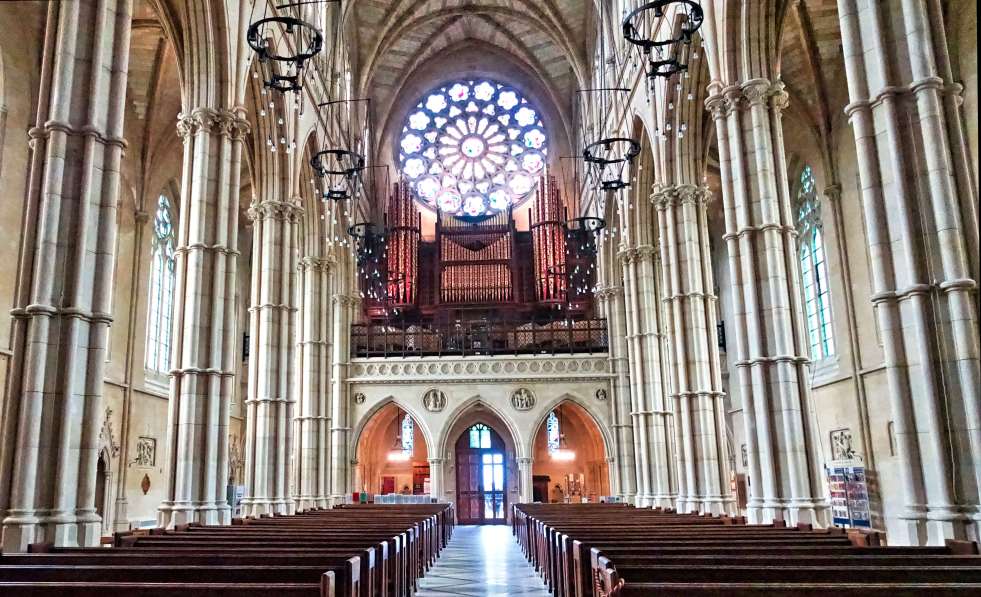

Looking down the length of the nave from the high altar is the best way to see the great rose window above the organ. It depicts the Blessed Virgin with the Holy Child surrounded by the 15 Mysteries of the Rosary. Just below is the organ which, when it was installed in 1875, needed some alterations to the casework to avoid masking part of the window. This is due to the fact that it was originally built for St. Johns Catholic Church in Islington. Just why it was never installed there is a mystery.

The Lady Chapel. The white and blue statue is of Our Lady of Lourdes to whom Duke Henry was particularly devoted. On the altar sits a rather unique object – the first English tabernacle made after the reformation. It was discovered in a lumber room in Cathedral House in 1976 and narrowly escaped being thrown out. Inside was a parchment stating that “This tabernacle was made by Chas. Kandler, Goldsmith at the Miter in St. Martin’s Lane for his Grace Thos Howard, Duke of Norfolk, Anno Dominie 1730”
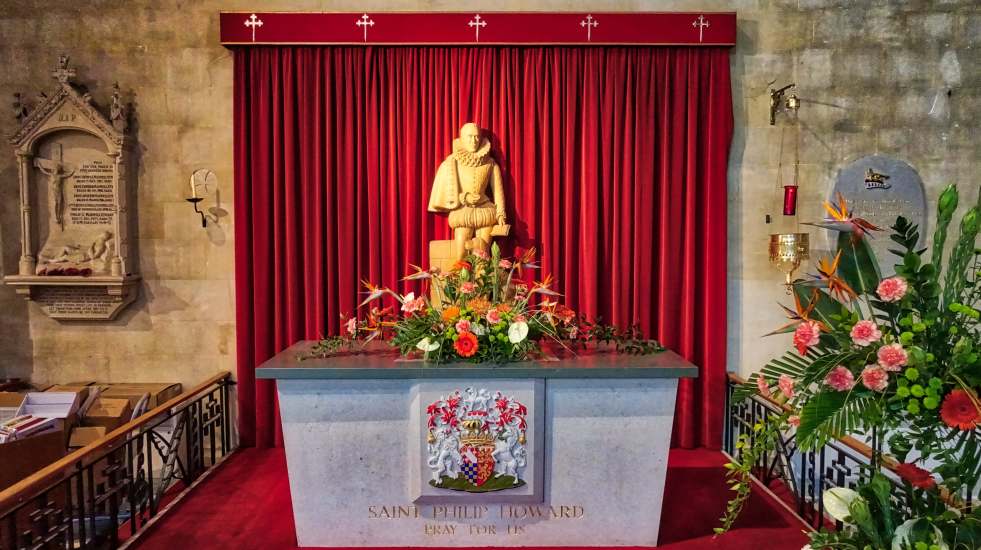
The Shrine of St Philip Howard. Like so many of his ilk, Philip Howard, Earl of Arundel (1557-1595) came to a sticky end, sentenced to be hanged, drawn and quartered, although mercifully he died before this hideous form of execution could be carried out. His father, Thomas, fourth Duke of Norfolk had fared no better – beheaded by Queen Elizabeth in 1572 for plotting to marry Mary, Queen of Scots. But, back to Philip. His life started well enough, married at 14, graduated at St John’s College, Cambridge at 17 and attended Queen Elizabeth’s Court when he was just 18. However, the turning point in his life came when he decided to reconcile with the Catholic Church at the age of 24 knowing full well that the decision could well cost him his life. Seeking religious liberty abroad, he sailed from Littlehampton but, after being betrayed by a servant, he was apprehended at sea and brought to the Tower of London where he remained as a prisoner for the next wretched 11 years. The trumped up charge that resulted in him being sentenced as a traitor was that he had prayed that the Spanish Armada would be victorious in their confrontation with the English navy. His remains, after several moves, rest in the sarcophagus shown above. He was beatified in 1929 and declared a saint by Pope Paul VI in 1971.

St. Wilfrid’s Chapel. St. Wilfrid (634-709) was Bishop of York, but after a dispute he sought refuge in Sussex, the last stronghold of paganism in Anglo-Saxon England. During his stay of six years he established the Christian faith, founded monasteries and churches and laid the foundations of the future diocese of Chichester. The chapel also serves as a war memorial to the men of Arundel who fell in both World Wars.
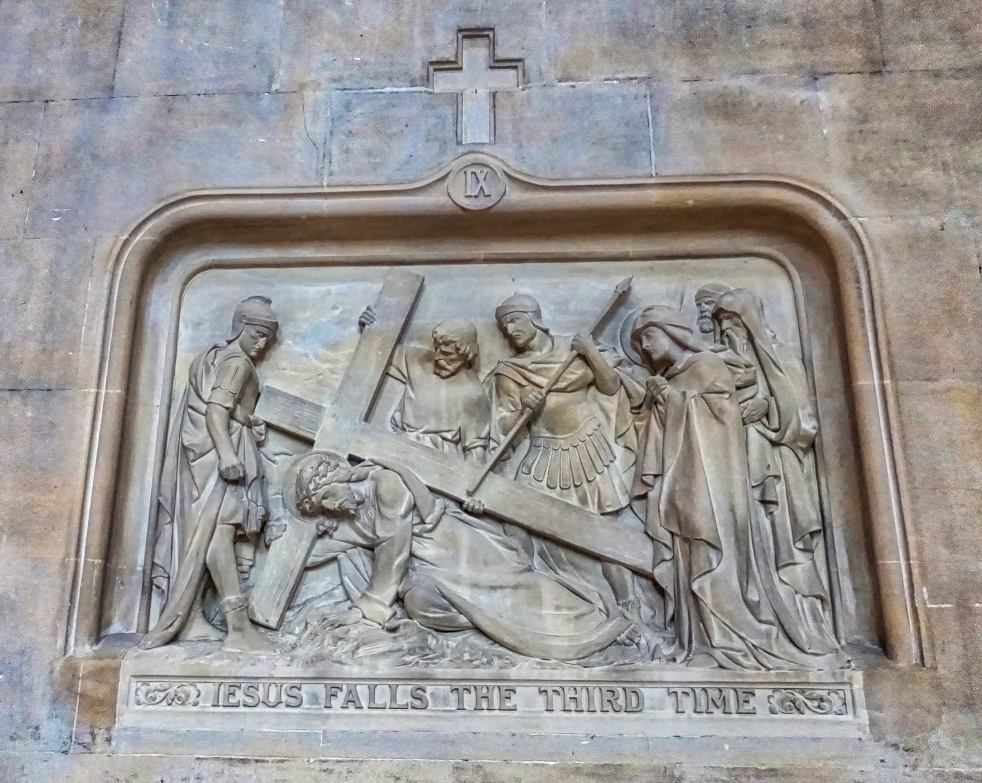
The 14 Stations of the Cross are always to be found in a Catholic church and here they are set into the wall, some in the north aisle and others in the south aisle. The detail in the stonework is beautifully precise as can be seen in this, the 9th station.
Arundel Church with the Fitzalan Chapel

After our visit to the Cathedral we called in for refreshment at the adjacent St Mary Gate Inn, an interesting old building in its own right which was constructed during the reign of Henry VIII. The freshly brewed coffee was enjoyable, despite the intrusive pop music that seemed incongruous in such a historic building.
Then across the road, through the impressive archway to the combined Arundel Church and Fitzalan Chapel. In the above photo, the Anglican church occupies the section beyond the central tower, (to the west), and the Catholic Fitzalan Chapel, of almost equal proportions, is to the east of the tower. When the building was originally constructed in the 14th century, what is now the Fitzalan Chapel would have been the chapel for a college that occupied the adjacent buildings. College staff would have supervised parish business, elected vicars and involved themselves in the life of the town. Later in the Middle Ages it became a centre for the composition and performance of choral music. At the time of the reformation the Collegiate Chapel became the property of the Henry Fitzalan, the Earl of Arundel to be used as the family mausoleum and in future would be known as the Fitzalan Chapel, a situation that has continued to the present day.

The archway to the church dates from the 19th century and was erected as a response to the grand Cathedral that had recently been completed on the opposite side of the road.

The interior is little changed from the the time when it was re-dedicated following an extensive restoration between 1855 and 1875. The work was carried out under the supervision of possibly the most famous architect of the day, Sir George Gilbert Scott whose work includes St. Pancras Station, the Albert Memorial and numerous churches and cathedrals throughout the country.


The chancel. The most remarkable feature is the carved stone pulpit which is built into the structure of the south west tower pillar which means that it is the same age as the church itself – very nearly 640 years. Stone pulpits of this age are rare indeed, but considering the quality of the carving it is unique.


There are remnants of church wall painting that date from the 14th century. They would have been have been obliterated on the orders of Henry VIII at the time of the reformation. Fortunately those who carried out the instructions merely covered them with whitewash and they remained hidden for over 300 years. They were re-discovered in 1873 but, during the early part of the 20th century, they suffered during a misguided attempt at preservation by using resin. Some more enlightened conservation work was carried out in the 1990’s, but more needs to be done. The best preserved painting is of the ‘Coronation of the Virgin’ – shown above – which depicts the Virgin Mary as Queen of Heaven where Heaven is imagined as an earthly court attended by angels.
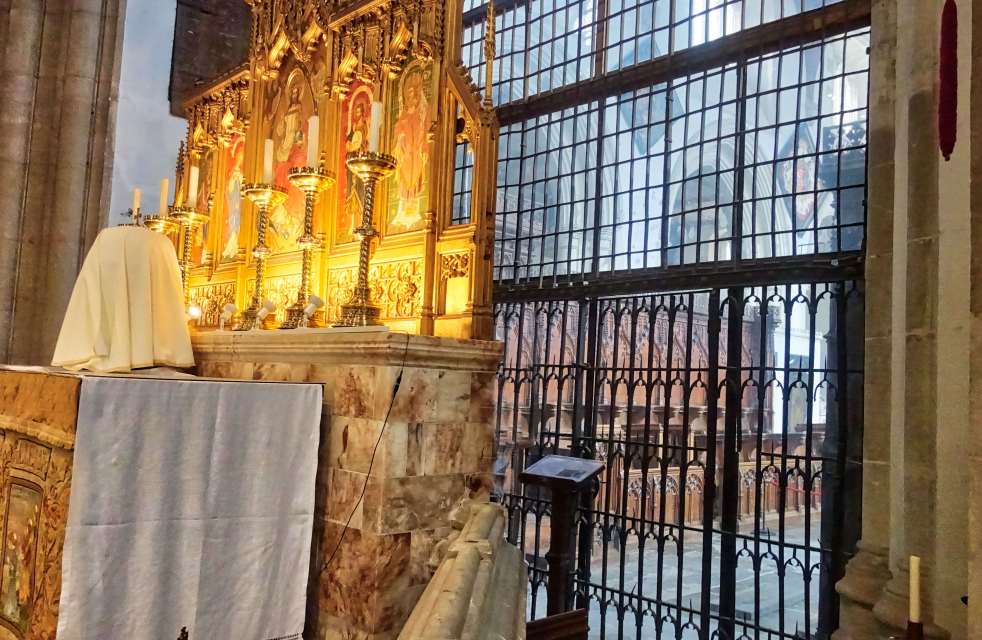
The wrought iron screen would have been installed in 1380 in order to firmly separate the Collegiate Chapel (now the Fitzalan Chapel) from the parish church

A glimpse through the metal screen at the Fitzalan Chapel which was badly damaged in 1643 during the siege of Arundel Castle by the Parliamentarians’ cannons during the English Civil War. It remained neglected until a comprehensive restoration was carried out at the end of the 19th century
Arundel Castle
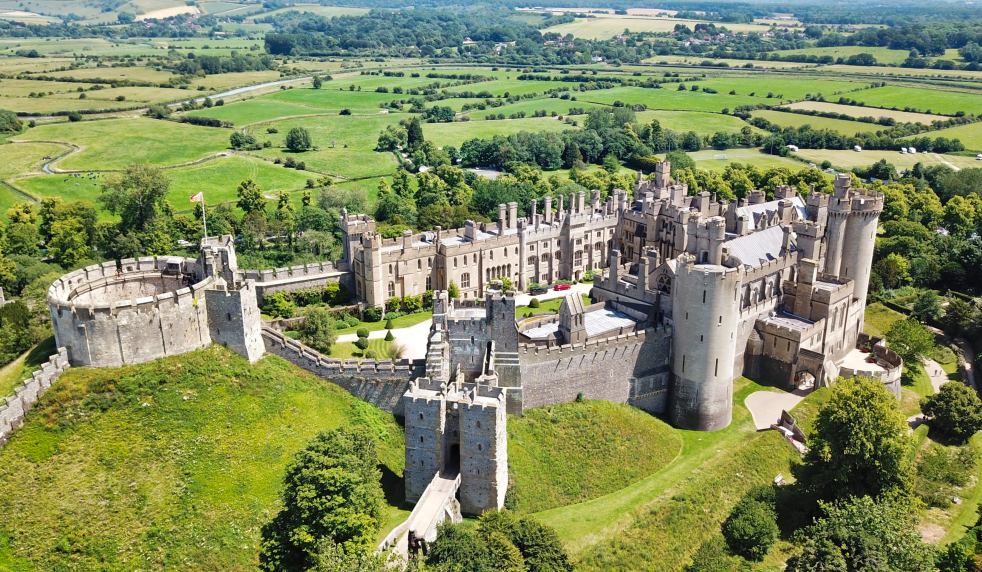
The magnificent castle, adjacent to the church and college buildings, was established in 1067. It was extensively damaged in the English Civil War then restored in the 18th and 19th centuries. It is the principal seat of the Howard family, whose heads were firstly the Earls of Arundel, then later the Dukes of Norfolk. It is open to the public, but unfortunately not on Mondays, the day of our visit.
Campania Restaurant
This was our third choice of dining venue as it seemed that most of Arundel shuts down on a Monday. The food was pleasant enough, but for me any enjoyment of the meal was literally dampened, as I had got extremely wet whilst walking the considerable distance from the parked car to the restaurant after being assured by BQ, who professed to know the town well, ‘it was just round the corner’. He strolled in 5 minutes later in his marine grade waterproof jacket smiling at my dishevelled appearance. Lunch was not our usual chatty occasion.

BQ’s Impressions
Arundel – A Town Divided.
In my parallel existence I write on cricket for a local freebie, so that any mention of the name Arundel immediately quickens the senses. For just north of the town there is the most beautiful county cricket ground I know of. Every season we in Hampshire make the pilgrimage from our “Concrete Coliseum” to celebrate with our arch-rivals Sussex, the glories of midsummer, whilst dozing contentedly in deck chairs.
But enough of this reverie for MW in his typical expediency of killing two birds with one stone had picked this visit to coincide with his car’s annual service. After being informed that the car would not be ready until the late afternoon, Arundel was picked, as it has enough interest to keep us occupied for the day. Unfortunately the weather was misty, warm and rainy – certainly not the day for our intrepid drone pilot who despite the conditions made two attempts to capture the splendid spread of the town.
When viewed from the by-pass on the south side, the town-scape is magnificent stretching from the castle battlements to the cathedral along the top of an escarpment, very reminiscent of the French castle towns of the Cathars in the Languedoc region of France which also suffered religious conflict. The story of the Dukes of Norfolk begins in Suffolk where the third duke was reprieved from execution by the death of Henry VIII on the day before he was due to be beheaded. His son the Fourth Duke married Mary Fitzalan and moved the family seat to Arundel. So typical of our strange island that all the nobility never seem to reside in their named counties. No parish church that we have visited could match in its interior the topsy-turvy convoluted history of Christianity in our kingdom. For here, in detail, is the split between the Church of England and Roman Catholicism graphically symbolised by a locked grill through which none shall pass. The separation of town and nobility is also architectural for as viewed through the grille the Fitzalan Chapel is a splendid perpendicular chamber with tombs below. Access can be obtained through the castle but as it was Monday it was shut. St Nicholas Church by contrast is a fine fourteenth century nave with a remarkable and unique beautifully carved pulpit and stalls.
Like most castle towns the civil war brought a high level of activity between the cavaliers and roundheads but this subsequent separation of the church after hundreds of years does not reflect favourably on either of the beliefs. However as we have seen in the ‘Brexit’ negotiations the separation of beliefs can still prove almost insurmountable. As a cradle English catholic I have, over my life, been used to practicing my religion in small converted premises or modern new buildings. The sheer opulence of the Cathedral points to a continental model which feels very alien in its small town Sussex setting. It is obviously a celebration of Catholic emancipation enacted by the Duke of Wellington (see earlier visit to Statfield Saye), and says more about victory than piety. After many visits compiling this blog I have found it easier to pray in the small ancient churches dating back to Anglo-Saxon times.
Having found a parking space immediately outside the Cathedral, which was fortunately within short walking distance of St Nicholas Church, our trip then descended into a Marx Bros farce. Again, being a Monday we had to investigate alternative restaurants as our original choice was shut. We booked a table at La Campania but, due to the steady rain decided to move the car closer. With my previous knowledge of the town I expertly guided MW around the narrow one way system and into a vacant parking spot, probably at the furthest possible point from our goal. On asking a local for directions to Las Campania she replied “ it’s just at the top of the road’’. After ten minutes walk in the rain I fell into the restaurant to discover a soaked MW and a frosty reception. When I had enquired earlier if he had brought a raincoat I was told that he had been assured that it would not rain! In order to make amends I offered to pay for the meal only to find that that my jacket and means of paying were ten minutes away in the car as I had changed into a comfortable and sensible waterproof anorak. If that were not bad enough MW then took a phone call from his mechanic to advise him his car needed replacement tyres that were not in stock and would not be available until the following day. At this point any memory of the meal completely vanished, but I do remember a rather quiet drive back, which I don’t think was due to my temporary deafness.
Our lunch
-
- Gamberoni Saltati BQ
- Caprese Bandiera style MW
- Linguine Alle Verdure BQ
- Risotto Lucia MW
- Merlot casa defra 2016 BQ & MW



I’m not long back from the Languedoc region and having visited quite a few castle towns, understand what BQ means of the similarity with the castle perched up there. That Cathedral is sure making a statement. The metal screen from this side, seems to be saying, ‘you can look but you’re not coming in from there’! I thought the Marx Bros farce so funny. It obviously doesn’t pay to believe ‘it won’t rain’ from the Met office. Thank you for another great read and photos.
LikeLike